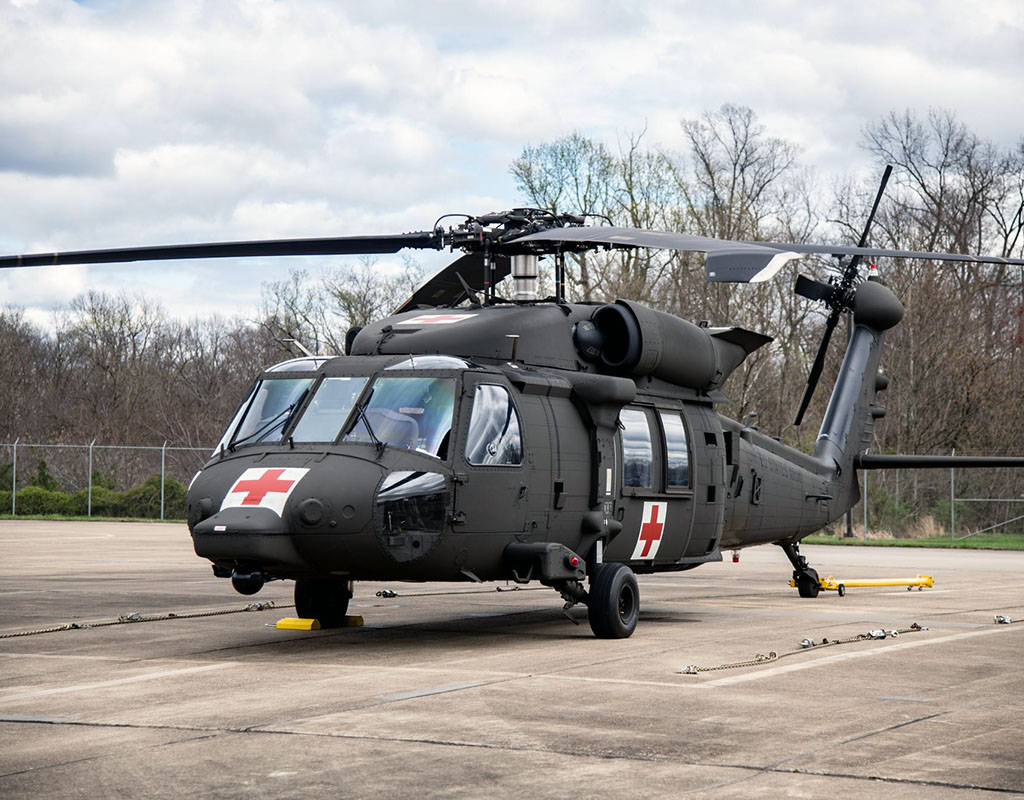
The West Virginia National Guard’s Company C, 2-104th General Support Aviation Battalion, Aeromedical Evacuation (MEDEVAC) Company, received its first of six new HH-60M “Mike” model Black Hawk helicopters at the Army Aviation Support Facility 1 in Williamstown, West Virginia, April 12.
Built by Sikorsky Aircraft for the U.S. Army, the HH-60M-model is specifically designed to support aerial medical and ambulatory patient transport MEDEVAC services such as evacuating wounded troops from the battlefield under difficult weather conditions, during day and night.
“The Mike model is a 30-year leap in technology with several improvements to existing Black Hawk designs,” stated Lt. Col. Harold Nicely, State Aviation Officer. “The new aircraft has a fully digitalized cockpit. Traditional gauges have been replaced by four multifunction displays for increased situational awareness. It is also fitted with dual digital flight control computer, moving map, storm scope and radio systems, and a GPS/inertial navigation system. All these features help to make the Mike model the most advanced military air ambulance helicopter platform in service.”
The HH-60M has two Full Authority Digital Engine Control (FADEC)-equipped T700-GE-701E engines that increase the helicopters performance including horsepower, cruising speed, rate of climb, lift capacity, and range. The HH-60M is also equipped with an improved durability gearbox along with newly designed composite rotor blades.
The aircraft comes with upgraded Forward Looking Infrared Radar (FLIR) and external hoist that make this Black Hawk better suited than current UH-60L “Lima” helicopters not only for MEDEVAC missions, but for search and rescue and swift water rescue missions as well.
The helicopter can fly at an air speed of 140.7 kilometers per hour with a range of 275.2 nautical miles. This range can be further increased by mounting an external fuel system of 400-gallon capacity. The empty weight of the helicopter is 14,470lb and the maximum hovering out of ground effect (HOGE) gross weight is 21,414lb.
The most important new features of the HH-60M however are on the inside of the airframe. The upgraded interior is specifically designed with a medical evacuation mission equipment package (MEP) kit and Integrated Vehicle Health Management System (IVHMS), making the helicopter a true dedicated air ambulance. The helicopter has on-board oxygen generation capability, as well as a reconfigurable interior with litters for transporting 6 patients along with crew and flight medics.
While the primary mission of the HH-60M is MEDEVAC, it can also be easily tasked to carry out personnel transport, search and rescue, resupply, aerial reconnaissance, cargo transport, and wildfire suppression missions, making it a truly multi-purpose aerial asset.
The HH-60M is manned by a pilot, co-pilot, crew chief and flight medic. It can accommodate up to 11 troops.
Pilots and command leadership are excited to be receiving the new aircraft.
“The new HH-60M airframe increases our ability to support emergency response missions throughout West Virginia, the rest of the nation, and during overseas deployments,” said Maj. Ryan Wolfe, commander of Co. C, 2-104th GASB. “This is the best aircraft the U.S. Army offers, and it tremendously enhances our capability to treat patients and fly safely in even the harshest of environments.”
The unit has already began training on the new aircraft and is expected to have all six within the next year. Pilots will be required to take a six-week instructional course to become familiar with all the upgraded avionics and flight control systems on the HH-60M to become certified on the new aircraft.
This press release was prepared and distributed by the West Virginia National Guard.

